R. Thukral
Padé Research Centre, England
Correspondence to: R. Thukral, Padé Research Centre, England.
| Email: |  |
Copyright © 2017 Scientific & Academic Publishing. All Rights Reserved.
This work is licensed under the Creative Commons Attribution International License (CC BY).
http://creativecommons.org/licenses/by/4.0/

Abstract
A new fourth-order Schroder-type method for finding zeros of nonlinear equations having unknown multiplicity is presented. In terms of computational cost the new iterative method requires five evaluations of functions per iteration. It is proved that the new method has a convergence of order four. Several numerical examples are given to illustrate exceptional convergence speed of the proposed method. The efficiency index of the proposed method is shown to be better than the established methods.
Keywords:
Schroder-type method, Root-finding, Nonlinear equations, Multiple roots, Order of convergence, Efficiency index
Cite this paper: R. Thukral, A New Fourth-order Schroder-type Method for Finding Multiple Zeros of Nonlinear Equations, American Journal of Computational and Applied Mathematics , Vol. 7 No. 2, 2017, pp. 58-63. doi: 10.5923/j.ajcam.20170702.05.
1. Introduction
Solving nonlinear equations is one of the most important problems in science and engineering [1, 2, 10]. In this paper, we present a new fourth-order iterative method to find multiple roots of the nonlinear equation. The root-solver is of great practical importance since it overcomes theoretical limits of one-point methods concerning convergence order and computational efficiency. In recent years, many modifications of the Newton-type methods for simple roots have been proposed and analysed [2] and little work has been done on multiple roots. In this paper, we are interested in the case that α is a root of multiplicity m>1 of a nonlinear equation. Therefore, the purpose of this study is to develop a new class of iterative method for finding multiple roots of nonlinear equations of a higher order than the existing iterative methods [1-10] and show further development of the Thukral third-order method [8]. In addition, the new iterative method is more precise than the classical Schroder method [4], Thukral third-order method [8], Thukral fourth-order method [9] and Soleymani et al. methods [5-9]. Hence, the proposed fourth-order method is significantly better when compared with these established methods.The remaining sections of the paper are organized as follows. Some basic definitions relevant to the present work are presented in section 2. In section 3, we construct a new iterative method and verify the order of convergence. In section 4, well-established methods are stated, which will demonstrate the effectiveness of the new fourth-order iterative method. Finally, in section 5, numerical comparisons are made to demonstrate the performance of the presented method.
2. Preliminaries
In order to establish the order of convergence of the new fourth-order method, we use the following definitions.Definition 1 Let  be a real-valued function with a root
be a real-valued function with a root  and let
and let  be a sequence of real numbers that converge towards
be a sequence of real numbers that converge towards  The order of convergence p is given by
The order of convergence p is given by | (1) |
where  and
and  is the asymptotic error constant [1, 3, 7-10]. Definition 2 Let
is the asymptotic error constant [1, 3, 7-10]. Definition 2 Let  be the error in the kth iteration, then the relation
be the error in the kth iteration, then the relation | (2) |
is the error equation. If the error equation exists, then p is the order of convergence of the iterative method [1, 3, 7-10]. Definition 3 Let r be the number of function evaluations of the method. The efficiency of the method is measured by the concept of efficiency index and defined as | (3) |
where p is the order of convergence of the method [3].Definition 4 Suppose that  and
and  are three successive iterations closer to the root
are three successive iterations closer to the root  . Then the computational order of convergence may be approximated by
. Then the computational order of convergence may be approximated by  | (4) |
where  [8].
[8].
3. Description of the Method and Analysis of Convergence
In this section we proceed to develop a new scheme to find multiple roots of a nonlinear equation. Our aim is to produce a method of higher order than the classical Schroder method, Thukral third-order method [8]. The classical Schroder second-order method is given as | (5) |
and recently Thukral [8] presented a third-order Schroder-type method,  | (6) |
with the initial guess of  sufficiently close to multiple root
sufficiently close to multiple root  We progress to define a new fourth-order iterative method for finding multiple roots of a nonlinear equation. In order to construct the new iterative method we require a total of five function evaluations. The new method is actually an improvement of the Thukral third-order method given [8]. Hence the new scheme is given as
We progress to define a new fourth-order iterative method for finding multiple roots of a nonlinear equation. In order to construct the new iterative method we require a total of five function evaluations. The new method is actually an improvement of the Thukral third-order method given [8]. Hence the new scheme is given as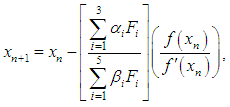 | (7) |
where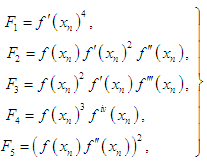 | (8) |
 | (9) |
 | (10) |
 is the initial guess and provided that the denominator of (7) is not equal to zero. Also, we have found that the new fourth-order method (7) can also be expressed as
is the initial guess and provided that the denominator of (7) is not equal to zero. Also, we have found that the new fourth-order method (7) can also be expressed as | (11) |
where | (12) |
 | (13) |
It is essential to analyse the order of convergence of the new iterative method.Theorem 1 Let  be a function for an open interval
be a function for an open interval  Let
Let  has a multiple root,
has a multiple root,  with multiplicity
with multiplicity  and
and  is the initial guess of the multiple root. Assume that
is the initial guess of the multiple root. Assume that  is a sufficiently differentiable function in I, then iteration defined by scheme (7) has fourth-order convergence and satisfies the error equation
is a sufficiently differentiable function in I, then iteration defined by scheme (7) has fourth-order convergence and satisfies the error equation | (14) |
where | (15) |
Proof Let  be a root of multiplicity m, that is
be a root of multiplicity m, that is  and
and  Since
Since  is a sufficiently differentiable function, therefore we expand
is a sufficiently differentiable function, therefore we expand  about
about  by the Taylor series. Also let
by the Taylor series. Also let  and using the Taylor series expansion of
and using the Taylor series expansion of  about
about  we have
we have | (16) |
 | (17) |
 | (18) |
 | (19) |
 | (20) |
where | (21) |
 | (22) |
 | (23) |
 | (24) |
 | (25) |
 | (26) |
From (16)-(20), we get | (27) |
 | (28) |
 | (29) |
 | (30) |
 | (31) |
Substituting appropriate expressions in (7) and simplifying, we have | (32) |
where | (33) |
The expression (33) establishes the asymptotic error constant for the fourth-order of convergence for the new Schroder-type method defined by (7). This completes the proof.
4. The Established Fourth-order Methods
For the purpose of comparison, four iterative methods presented in [5-9] are considered. Since these methods are well established, the essential formulas are used to calculate the multiple roots of the given nonlinear equations and thus compare the effectiveness of the new fourth-order method. The first fourth-order method presented by Thukral is given in [9], which is actually based on the classical Schroder method and the scheme is expressed as | (34) |
 | (35) |
The second fourth-order method presented by Thukral is also given in [9], and this method is based on Thukral third-order method [8], the scheme is given as | (36) |
 | (37) |
The first fourth-order method presented by Soleymani et al. [5], is expressed as | (38) |
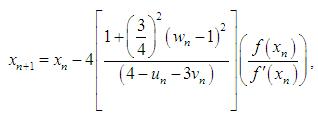 | (39) |
where  | (40) |
 | (41) |
 | (42) |
The second fourth-order method is by Soleymani et al. [6], and is given as | (43) |
 | (44) |
where  and
and  are given by (40), (41), (42) respectively.
are given by (40), (41), (42) respectively.
5. Numerical Results
We present the numerical results obtained by employing the iterative methods (6), (7), (36), (38), (40), (45) to solve some nonlinear equations with unknown multiplicity m. To demonstrate the performance of the new fourth order iterative method, we use ten particular nonlinear equations. The performance obtained by each of the methods is displayed in the following tables. In fact, the errors displayed are of absolute value and insignificant approximations by the various methods have been omitted in the following tables. The new fourth-order method requires five function evaluations and has the order of convergence four. To determine the efficiency index of the new method, definition 3 will be used. Hence, the efficiency index of the new method given by (7) is  which is better than the Thukral fourth-order methods given by (36) and (38) and the Soleymani et al methods (40) and (45),
which is better than the Thukral fourth-order methods given by (36) and (38) and the Soleymani et al methods (40) and (45),  The efficiency index of the Thukral third-order method (6) is
The efficiency index of the Thukral third-order method (6) is  whereas the efficiency index of the Schroder second-order method (5) is
whereas the efficiency index of the Schroder second-order method (5) is  The test functions, multiplicity m and their exact root
The test functions, multiplicity m and their exact root  are displayed in table 1. The difference between the root
are displayed in table 1. The difference between the root  and the approximation
and the approximation  for test functions with initial guess
for test functions with initial guess  are displayed in table 2. Table 2 shows the absolute errors obtained by each of the iterative methods described, we see that the new fourth order method is producing better results than the established methods. Furthermore, the computational order of convergence is displayed in table 3. In fact,
are displayed in table 2. Table 2 shows the absolute errors obtained by each of the iterative methods described, we see that the new fourth order method is producing better results than the established methods. Furthermore, the computational order of convergence is displayed in table 3. In fact,  is calculated by using the same total number of function evaluations for all methods.
is calculated by using the same total number of function evaluations for all methods. Table 1. Test functions, multiplicity m, root α and initial guess x0
 |
| |
|
Table 2. Comparison of iterative methods
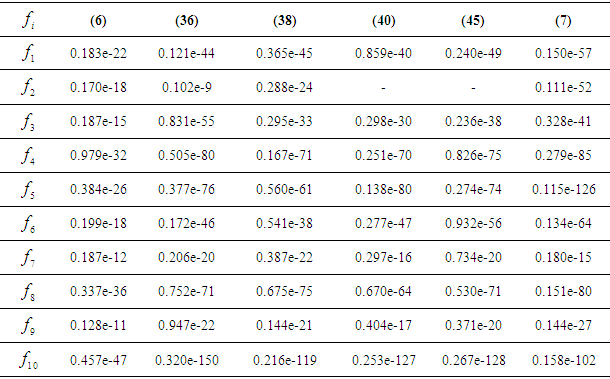 |
| |
|
Table 3. Performance of computational order of convergence
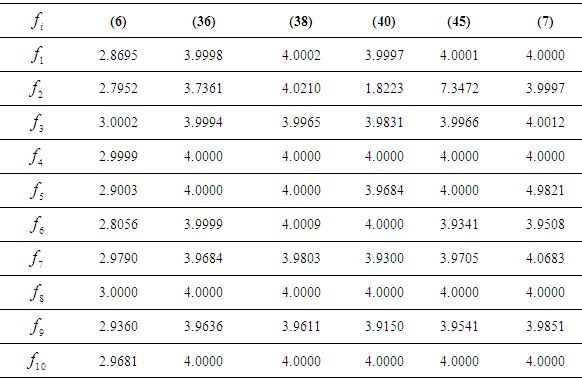 |
| |
|
6. Remarks and Conclusions
A new fourth-order iterative method for solving nonlinear equations with multiple roots has been introduced. We have shown analytically that the new method has fourth-order of convergence. The prime motive for presenting the new method was to establish a higher order of convergence method than the existing third order method [8] and improve the efficiency of the fourth-order methods given [5, 6, 9]. The effectiveness of the new fourth-order method is examined by showing the accuracy of the multiple roots of several nonlinear equations. After extensive experimentation, it can be concluded that the convergence of the new fourth-order method is remarkably fast and is very competitive with other similar methods. We have shown numerically and verified the efficiency of the new iterative method.
References
| [1] | W. Gautschi, Numerical Analysis: an Introduction, Birkhauser, 1997. |
| [2] | M. S. Petkovic, B. Neta, L. D. Petkovic, J. Dzunic, Multipoint methods for solving nonlinear equations, Elsevier 2012. |
| [3] | A. M. Ostrowski, Solutions of equations and system of equations, Academic Press, New York, 1960. |
| [4] | E. Schroder, Uber unendich viele Algorithmen zur Auflosung der Gleichungen, Math. Ann. 2 (1870) 317-365. |
| [5] | F. Soleymani, D. K. R. Babajee, Computing multiple zeros using a class of quartically convergent methods, Alex. Eng. 52 (2013) 531-541. |
| [6] | F. Soleyani, S. Shateyi, G. Ozkum, An iterative solver in the presence and absence of multiplicity for nonlinear equations, The Scientic World Journal, vol 2013, article ID 837243. |
| [7] | R. Thukral, New variants of the Schroder method for finding zeros of nonlinear equations having unknown multiplicity, J. Adv. Math. 8 (3) (2014) 1675-1683. |
| [8] | R. Thukral, New third-order Schroder-type method for finding zeros of solving nonlinear equations having unknown multiplicity, Amer. J. Comput. Appl. Math. 5 (5) (2015) 147-153. |
| [9] | R. Thukral, New fourth-order Schroder-type methods for finding zeros of nonlinear equations having unknown multiplicity, Brit. J. Math. Computer Sci. 13(1) (2016) 1-10. |
| [10] | J. F. Traub, Iterative Methods for solution of equations, Chelsea publishing company, New York 1977. |



 be a real-valued function with a root
be a real-valued function with a root  and let
and let  be a sequence of real numbers that converge towards
be a sequence of real numbers that converge towards  The order of convergence p is given by
The order of convergence p is given by
 and
and  is the asymptotic error constant [1, 3, 7-10]. Definition 2 Let
is the asymptotic error constant [1, 3, 7-10]. Definition 2 Let  be the error in the kth iteration, then the relation
be the error in the kth iteration, then the relation

 and
and  are three successive iterations closer to the root
are three successive iterations closer to the root  . Then the computational order of convergence may be approximated by
. Then the computational order of convergence may be approximated by 
 [8].
[8]. 

 sufficiently close to multiple root
sufficiently close to multiple root  We progress to define a new fourth-order iterative method for finding multiple roots of a nonlinear equation. In order to construct the new iterative method we require a total of five function evaluations. The new method is actually an improvement of the Thukral third-order method given [8]. Hence the new scheme is given as
We progress to define a new fourth-order iterative method for finding multiple roots of a nonlinear equation. In order to construct the new iterative method we require a total of five function evaluations. The new method is actually an improvement of the Thukral third-order method given [8]. Hence the new scheme is given as



 is the initial guess and provided that the denominator of (7) is not equal to zero. Also, we have found that the new fourth-order method (7) can also be expressed as
is the initial guess and provided that the denominator of (7) is not equal to zero. Also, we have found that the new fourth-order method (7) can also be expressed as


 be a function for an open interval
be a function for an open interval  Let
Let  has a multiple root,
has a multiple root,  with multiplicity
with multiplicity  and
and  is the initial guess of the multiple root. Assume that
is the initial guess of the multiple root. Assume that  is a sufficiently differentiable function in I, then iteration defined by scheme (7) has fourth-order convergence and satisfies the error equation
is a sufficiently differentiable function in I, then iteration defined by scheme (7) has fourth-order convergence and satisfies the error equation

 be a root of multiplicity m, that is
be a root of multiplicity m, that is  and
and  Since
Since  is a sufficiently differentiable function, therefore we expand
is a sufficiently differentiable function, therefore we expand  about
about  by the Taylor series. Also let
by the Taylor series. Also let  and using the Taylor series expansion of
and using the Taylor series expansion of  about
about  we have
we have




























 and
and  are given by (40), (41), (42) respectively.
are given by (40), (41), (42) respectively.  which is better than the Thukral fourth-order methods given by (36) and (38) and the Soleymani et al methods (40) and (45),
which is better than the Thukral fourth-order methods given by (36) and (38) and the Soleymani et al methods (40) and (45),  The efficiency index of the Thukral third-order method (6) is
The efficiency index of the Thukral third-order method (6) is  whereas the efficiency index of the Schroder second-order method (5) is
whereas the efficiency index of the Schroder second-order method (5) is  The test functions, multiplicity m and their exact root
The test functions, multiplicity m and their exact root  are displayed in table 1. The difference between the root
are displayed in table 1. The difference between the root  and the approximation
and the approximation  for test functions with initial guess
for test functions with initial guess  are displayed in table 2. Table 2 shows the absolute errors obtained by each of the iterative methods described, we see that the new fourth order method is producing better results than the established methods. Furthermore, the computational order of convergence is displayed in table 3. In fact,
are displayed in table 2. Table 2 shows the absolute errors obtained by each of the iterative methods described, we see that the new fourth order method is producing better results than the established methods. Furthermore, the computational order of convergence is displayed in table 3. In fact,  is calculated by using the same total number of function evaluations for all methods.
is calculated by using the same total number of function evaluations for all methods.  Abstract
Abstract Reference
Reference Full-Text PDF
Full-Text PDF Full-text HTML
Full-text HTML

